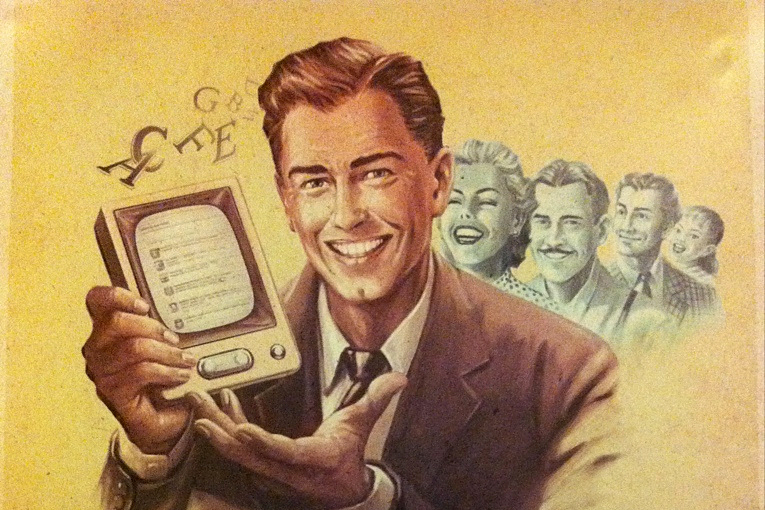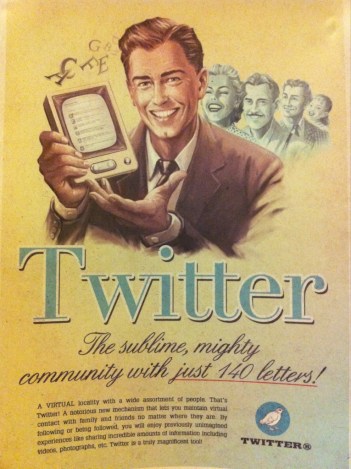Twitter is dangerous. Each time you toss a thought out into the world and receive a response, your brain releases a burst of endorphins, as though you took a little bump of cocaine. You can get hooked on it, returning again and again for another fix, even at the expense of other parts of your life or work. I myself have lost countless hours to Twitter — as of this writing, I have tweeted 88,210 times.
And I’ve loved it! That’s one reason I’m quitting for a while: As much as I do it, it’s all I can do not to do it more. Even now, I know I could hop over, ask a question or make an observation, and get responses — helpful responses, funny responses, combative responses, all the above — within seconds. It is, when you think about it, an introvert’s dream: a way to interact with others entirely on one’s own terms, revealing as much or as little as one chooses, without the awkwardness of small-talk and other vicissitudes of face-to-face interaction.
The danger of Twitter, as with all social media, is that bullshit starts to seem meaningful. The human brain amplifies each bit of feedback, so one nasty comment can ruin your day; one compliment can make you feel like a hero. If something you say gets retweeted a bunch, you feel like you’re changing the world. A half-dozen #Sharknado tweets can make Sharknado seem like something that matters. (It isn’t.) It’s very easy to get a warped perspective.
However, if you can keep it contained — i.e., self-regulate better than I can — Twitter is an incredibly useful professional tool. I’ve connected with people who never otherwise would have come to Grist. I’ve been able to expose a much broader range of people to my concerns and my writing.
With all the hours I’ve spent on Twitter — and I shudder to think of the total — I’ve seen a lot of what works and what doesn’t. I’ve seen lots of dumb patterns repeat themselves and I’ve seen lots of fantastic serendipities, synchronicities, and, y’know, funny zingers.
Forthwith, here are a few tips for those of you seeking to build a following, expose your work to more (and more influential) people, and generally have an enjoyable twitsperience.
1. Be good.
It helps to enter Twitter with a large following already in tow. (Witness Beyonce amassing over 11 million followers on the strength of eight utterly banal tweets.) It also helps to know important people who can give you a kick-start. If you’re starting fresh, as an unknown, it can take a long time to build a substantial audience.
Nonetheless, especially relative to other forms of media, Twitter remains remarkably meritocratic and egalitarian. It is possible for anyone to get noticed by being good.
Being good can mean lots of different things, obviously, but the most important is simply making an effort. It always amazes me that people, even professionals on Twitter in a professional capacity, use it as a kind of toilet where they flush every typo-ridden, ungrammatical thought that drifts through their mind. It may not seem like it, but Twitter is writing — writing in a particular medium, with its own limitations and conventions, but writing nonetheless. Think about what you want to share. Write grammatically when possible. Don’t make #hashtags out of #every #word, because that makes your writing hard to read. Excellence and Twitter are not mutually exclusive.
2. Mix it up.
It’s possible to amass a large following by doing one thing; @everyword is tweeting every word in the English language, one at a time, and it’s got 60,000 followers. But if you want to be known as a journalist, researcher, or thinker, especially one focusing on a particular subject matter like global warming, you need to offer some variety. A feed filled with nothing but dire climate forecasts is, to say the least, of limited interest.
If writing a blog post is like sitting in a bar with a friend, Twitter is like standing around at a cocktail party. It is by nature more performative — even if you’re talking directly with one person, lots of other people are listening in. If you’re serious all the time, you’re going to be a bit of a bore. Same if you’re combative all the time. Or goofy all the time. Or anyway, that’s been my thought. So I tweet substantive climate links and random movie or music links, serious observations and crude jokes, funny quotes from my kids and, yes, pictures of my meals.
There’s no getting around the fact that it’s a somewhat narcissistic undertaking. You’re “lifecasting” with the presumption that your life and thoughts are of some interest.
But it’s not purely narcissistic. It’s also a strategy. After all, I’m not a credentialed expert in anything; I’m an autodidact and a dilettante. I have no argument from authority. If anyone’s going to care what I have to say about climate change or anything else, it’s going to be because they feel like, in some small measure, they know me and trust my judgment.
We are social creatures; we are more likely to listen to those who share some part of our cultural identities. From a rational point of view, it doesn’t makes sense that someone would be more open to my climate thoughts because they agree with me about green bell peppers. But humans are not particularly rational. If you can build a tribe online through engagement on other topics, whether it’s Anthony Weiner or the Academy Awards (or bell peppers), those people will be more open to hearing what you think about climate change (or Solyndra, or public transportation, or urban density, or whatever). It’s a way of demonstrating that People Like Us care about Things Like That — which is particularly important when it comes to climate, which is still largely viewed as the province of monomaniacal environmentalists.
3. Engage, but know when to engage.
You see two things a lot on Twitter.
One is some earnest person getting strung along, roped into a vicious, endless argument, growing more and more shrill and defensive. “I’m making such solid factual points and my darn interlocutor just won’t acknowledge them!” It’s sad. Twitter, like anywhere else online, has its share of hacks and ideologues. Some people are only there to high-five people who think like they do and torment people who don’t. There is no margin in seeking common ground or a civil exchange of views with such folk. Don’t let yourself be tormented for show. That’s not to say there’s no reason to address the hacks, but understand that it is purely for the benefit of others watching; the hack’s mind isn’t going to change.
The other thing you see a lot is someone — and this is usually, though not exclusively, someone with professional credentials — barging into Twitter with incredibly thin skin, taking every question or mention as an attack. (I’m not going to say older white men are disproportionately subject to this, but … they are.) If you operate on a perpetual hair-trigger, you’re going to miss out on lots of opportunities to connect with people outside your normal circles.
There have been many times when I’ve poked someone with a sharp stick (as it were), mocked or caricatured something they’ve written, only to have them respond calmly or humbly or with humor. When that happens, I immediately close the bomb doors and switch to real engagement mode.
And it’s happened the other way around too: I get attacked, and rather than chucking a grenade back, I ask a sincere question or make a point of clarification. And you’d be surprised — lots of people who come at you like tigers will turn into kittens when shown a modicum of civility and respect.
For this to happen, though, you must be willing to give it a try, even when under attack, even when your ego is twitching and defensive. And you must also be willing to credit an “enemy,” someone in some opposing camp, with humanity and reason when they show it. It’s difficult — ego’s a bitch — but in my experience, some of the most rewarding exchanges come out of this process. Many of my favorite interlocutors on Twitter are right-wing nutjobs. (I kid! Sort of.)
There’s no formula for telling the difference between someone who’s a pure hack and someone who is reachable, between an argument that’s purely theatrical and an argument that’s a sincere attempt to clarify differences and find common ground. It’s an art. God knows I’ve gotten it wrong dozens of times. But it’s worth the effort to get better at it. You might even sneak some climate sanity into unexpected quarters.
4. Be helpful to people you look up to and kind to those who look up to you.
Twitter is still astoundingly unmediated. It is possible to direct a comment to Bill Clinton, the Pope, Miley Cyrus, or any of dozens of celebrities, journalists, scholars, and politicos, and there’s a small but not negligible chance they’ll read it and respond! It’s amazing when you think about it. Whatever area you’re in, whatever you write about, you can probably find the top names in your field on Twitter and reach them directly.
Please, do not ever tweet one of these people and say, “The dolphins in Malaysia are crying out for help! Please RT!” I never, ever respond to requests to retweet, good cause or no. To me that crosses the line into marketing, and one of the greatest things about Twitter is that it’s possible to avoid marketing and canned “messaging” if you want to.
Instead, engage people you admire (or whose opinion carries weight in your field) by answering their questions, sharing information or links they might not have, and pointing them in new directions. Be a steady and helpful presence, not a cheerleader or a nag. And they will notice; it’s not hard to stand out from the crowd. Their attention will translate into more followers and more reach for you.
Similarly, if you’ve built up a sizable following, don’t turn into a jerk. (Helpfully, this advice also applies to Real Life.) Engage people, answer their questions, take them seriously, even if they have few followers and little influence. It will strengthen your tribe.
You’ll notice that very little of this is specifically about communicating climate change. Nonetheless, it’s relevant. The thing about climate change is that very few people want to hear about it. It’s pretty depressing. So spreading the word, especially to circles of influence, requires a little bit of song and dance, a little bit of seduction and flash. Being good at Twitter will naturally make you a better climate communicator.




